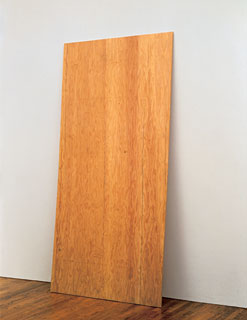|
| |
 |
|



|

Plywood, 1987, Laminated fir, 94 3/4 x 47 x 5/8 inches, Collection of Andrew Ong.
|

Robert Gober's rich and unsettling iconography—from the dysfunctional sinks, handcrafted furniture, and printed wallpaper to the truncated body parts and mysterious storm drains—has unfolded sequentially over the past two decades. Each new series appeared seemingly unprecedented and surprisingly fresh in its bold narrative form. What links these formally distinct works—encountered as individual objects or combined in startlingly beautiful installations—is the artist's ongoing exploration of the intersection between emotional, psychological, and spiritual states with the social forces that shape our contemporary culture.
Gober's aesthetic vocabulary, which invokes a specifically American vernacular, has roots in Minimalist reduction. His early and defining ghostly white sinks, crafted from plaster, wood, and enamel paint, are almost abstract in their refusal to function. Displayed on the wall (like actual sinks), these works reject the sculptural pedestal, evoking instead comparisons to Donald Judd's wall-mounted progression pieces. Gober's deliberately banal sheet of wood in Plywood similarly recalls Minimalist strategies of industrial production and simple, uninflected forms. But, as with the sinks, the plywood is actually handwrought, a carefully crafted illusion made to look store-bought.
In his two-part sculpture Untitled (2000–01) Gober cast a block of Styrofoam in bronze, made duplicate forms, and painted the Styrofoam with great verisimilitude. These heavy replicas of a featherlight material rest on the floor, one partially covering a plank of ersatz plywood, the other bearing its weight. Perhaps one of Gober's most deliberately "formal" works, it directly evokes and plays with the language of traditional sculpture in its emphasis on the relationship between object and pedestal. Yet, as in all of Gober's art, the sculpture is imbued with poetic content. The artist found the Styrofoam washed up on a beach, and its representation in his work is a paean to the detritus of American culture.
|
|